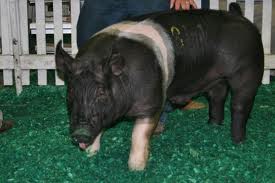
|
Harmony and Luckiness Imp.&Exp. Co., Ltd. |
|
|||
Products Category |
Swine-HampshireProduct name : Swine-Hampshire Item : P-04 Details :The Hampshire pig is a domestic swine breed characterized by erect ears and a black body with a whitish band around the middle, covering the front legs. The American National Swine Registry notes this is the fourth "most recorded breed" of pigs in the United States, and probably the oldest American breed of hogs. It is believed to have derived from the Old English Breed, found in northern England and Scotland. Importations of this hog breed to America were thought to have been made from Hampshire in England between 1827 and 1839. Pigs remaining in this part of England developed later into the Wessex Saddleback, a similarly colored pig, but with flop ears and kept largely for foraging in forest. Residents of Hampshire are often colloquially referred to as "Hampshire Hogs", a name which goes back at least to the 1790s. Hampshire hogs are noted for being well-muscled and rapid growers, and for exhibiting good carcass quality when used as meat animals. When used as breeding stock, the sows of this breed have been praised for their capacity as mothers, having "extra longevity in the sow". Hampshires are good tempered; they do not grow as fast as many cross-breds, but they do grow faster than Yorkshires. All in all, Hampshires are a very neat breed of hog. They are large, hardy, intelligent animals that really don’t need human intervention to thrive. They simply tolerate us in their vicinity as long as we feed them. Hampshire hogs are very distinctive animals. The first thing you will notice about a Hampshire is their black and white markings. They look rather like an oreo cookie with legs. Their head, ears, and shoulders are usually black, as are their rear legs and tail. The ‘cream filling’ can take up as much or as little of the center portion of the animal as needed. Some pigs have a generous helping, extending from their shoulders to their hips, while others were cheated, having only a thin stripe. The next thing you will notice is their large upright ears. The ears on a Hampshire hog are quite different from those of, say, a Duroc. A Hampshire’s ears are reminiscent of an agitated African elephants ears, if you’ve every watched the nature channels. They don’t flap (much), but they are very expressive. If you know what to look for, you can tell exactly how a Hampshire is feeling by their way their ears are held. It’s been said that Hampshires are easy-going animals, but I’ve not found that to be the case. I grew upon a hog farm in southern Colorado, and we dealt with a lot of Hampshires. Therefore, I do know a little about what I’m saying here. That being said, Hampshires aren’t know for sneak attacks like some breeds. You just want to keep an eye on them when you are working with them. Hampshires are a favorite of small farmers because they have large, healthy litters, and you can cross them with nearly any other breed and those traits will hold true. Litters are usually between 8 and 14 piglets. Hampshire sows make excellent mothers. However, you do NOT want to get between a sow and her litter during the first couple of days. If the sow is used to being handled, after about five days you can put her into a pen with the babies and then handle the babies all you want. She will watch you to make sure that you aren’t hurting her babies, but as long as you move slowly and carefully and aren’t hurting them piglets, you can do pretty much anything to them. THEY may think you’re killing them, but she’ll be fine. Hampshires are fast growing animals. They have legs that are longer than some other breeds, such as Durocs. Their noses are somewhat longer as well. They are very easy keepers as well. A diet of ground hay with a little corn will put weight on a Hampshire very quickly. However, they are happiest when they can get out and forage for themselves as well (and believe me, you won’t be able to keep them in). Iron weed and bull nettle seem to be two of their favorite types of weeds (at least in Colorado), so you might as well fence in a pasture full of it for them. A Hampshire is happiest with a full feeder, a full waterer, lots of weeds to eat, and, of course, the always necessary mud hole. Since hogs have sweat glands only on the back legs, a mud hole is actually a necessity for them. The mud helps keep them cool and protects their skin from the sun and from insects. A pig with a sunburn is a pitiful sight, indeed.  Send Inquiry : |
Copyright © 2026 Harmony and Luckiness Imp.&Exp. Co., Ltd. All Rights Reserved







 Cattle
Cattle  Swine
Swine 
